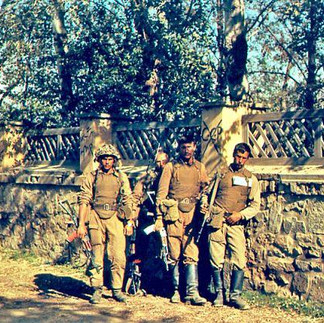This article is made from the viral thread in our twitter account. For those of our readers who are not on twitter, we have made this blogpost for more convenient reading. Other entries on Soviet equipment used during the Soviet-Afghan War can be found in this list. Also, we have an article on every Soviet vest, so this one is just a quick rundown on all of them.

SN - Stalnoi Nagrudnik, Steel Vest
The first official and mass produced Soviet body armor was developed just before the Second World War and was essentially a WW1 concept of metal sheet worn on torso. The effectiveness was poor, but it could withstand pistol rounds which weren’t rare at the time.
6b1 - the first modern one
After the WW2, Soviets didn’t invest much into the idea of body armor. However, in 1950s, some experiments were carried out. These trials produced 6b1 body armor. It was a very interesting concept, later used in also failed Dragonskin body armor. This body armor was only a trial piece of equipment, but was produced in Soviet numbers. The exact number is not known, but it is at least in thousands.
Even now, dozen of collectors own it. After the invasion of Afghanistan, someone remembered that there is an off-the-shelf solution. A reasonable number of these vests needed up there, photographic evidence suggests that a lot of different units received them. From collectors point of view these are now rare and expensive. Estimated a hundred is circulating in collectors field, but they rarely change hands. If you see one for grabs - do not hesitate.
6b2 - the most Afghan one
But 6b1 was never a good option - neither for the user nor for the industry. Another solution was required and it was provided by the Soviet engineers - 6b2. Being developed just before the Afghan campaign it quickly became mass produced. This body armor could actually stop shrapnel and pistol caliber bullets. And it was reasonably comfortable.
Now, it is the golden standard for Soviet-Afghan reenactment, as it was used throughout most of the conflict. These body armors are now rare, especially in decent condition. For some reasons, post soviet armies had a habit of cutting metal plates from this armor. But even chopped vests can go for couple of hundred dollars.
6b2-3tm - the weird one
This is one of the more mysterious body armor vests of the Soviet army. Seen as a transitional between 6b2 and 6b3, it is not exactly clear what this thing was and why some designers decisions were made. However, it is also a rare and valuable collectors item. There are probably less of them than known 6b1 vests so…
6b3 - the standard one
The most common body armor for Soviet Afghan reenactment and probably second most common in the actual conflict. These were produced in huge numbers and are still available at decent prices. The armor itself was a big improvement comparing to 6b2 - it now had a chance to stop an assault rifle bullets and was more comfortable, though heavier. Integrated pouches made sense - magazines, grenades and some utility pockets. While it is mostly associated with Afghan, the 6b3 vest was actually used in other conflicts, including recent ones. However, by all means, it was outdated by late 80s
6b4 - the most expensive one
The 6b4 was the best and most thought through out of all Soviet body armor vests. It was, however, the most expensive and heavy Soviet vest, so not many of them were produced.
They were really good in terms of their ballistic characteristics - not only they stopped rifle rounds, but the user wouldn’t be seriously harmed, unlike with all other vests.
These body armors seen some limited use in almost every Soviet and post Soviet conflict. Generally valuable, usually come in complete sets with ballistic plates.
6b5 - the long survivor
The latest and most common Soviet body armor. Produced in hundreds of thousands by different factories, in different camouflage patterns and used in every conflict until very recent years.













































Bình luận